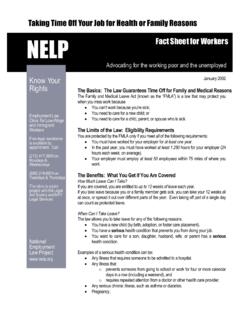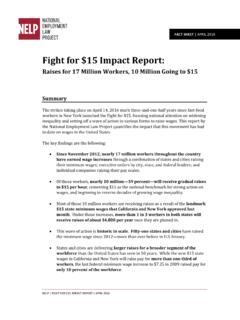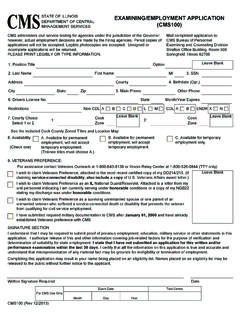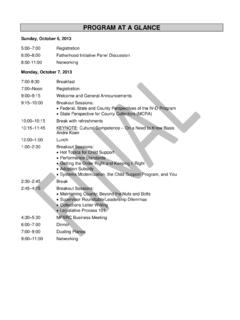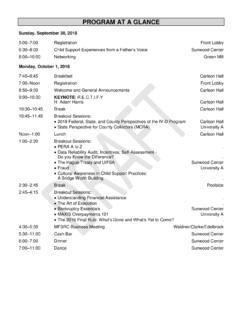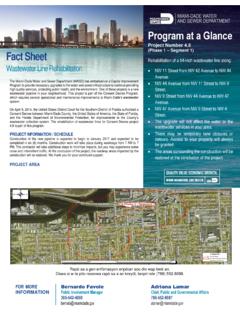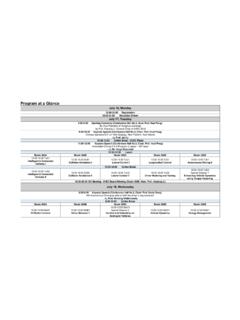Transcription of Tennessee’s Unemployment Program At-A-Glance
1 Tennessee s Unemployment Program At-A-Glance By National Employment Law Project, January 2007 Overview Unemployment insurance plays an important role in Tennessee s economy. Over the past year, 143,000 Tennessee residents received UI benefits, with each individual receiving an average of 14 weeks of assistance. $408 million in benefits were paid out to these recipients over the past year, maintaining the stability of families dealing with temporary joblessness. Moreover, these dollars were recycled through local economies as increased consumer spending. Yet because of the weaknesses in the Program , Tennessee s economy gets less of a boost from the Unemployment Program than it could if it followed the example of some of the other states in the region. Tennessee is firmly a Mid South economy, seeking to develop a value-added economy that provides its residents a higher quality living than is traditionally associated with the Deep South (Louisiana, Alabama, and Mississippi).
2 Table 1 compares the Unemployment Program in Tennessee to six similar nearby state economies. Table 1 UI Benefit Measures, Tennessee and Nearby States Recipiency Rate (Percent of the Jobless Collecting UI) Average Weekly Benefit Amount Maximum Weekly Benefit Amount Replacement Rate (Weekly UI Benefits as the Percent of the Average Wage) Average Number of Weeks of UI Received Per Worker Tennessee 26% $ $275 Arkansas 40% $ $395 Georgia 24% $ $320 Kentucky 25% $ $401 Missouri 32% $ $270 North Carolina 37% $ $457 Virginia 25% $ $347 Average 36% $ NA Source: Department of Labor UI Quarterly Data Summary, 3rd Quarter 2006 and Significant Provisions of State UI Laws, July 2006, all figures are for the past twelve months except the replacement rate Only one out of 4 jobless workers in Tennessee receive UI The best overall measure of a state s UI Program is the recipiency rate, which is the best available measure of the percent of the unemployed that collect jobless Only a quarter of Tennessee s jobless receive Unemployment compensation which badly trails the goal of covering half of the jobless in a well performing Program .
3 And while Tennessee joins other states in the region that fall short of the national average (36%), nearby North Carolina and Arkansas have established programs that reach a greater share of the jobless. UI Benefits Are Insufficient to Protect Working Families in Tennessee Another key question is whether UI checks are sufficient to meet the basic needs of the unemployed the central purpose of the Program . In the US, the goal historically has been a fifty percent wage replacement standard, meaning that UI checks are equivalent to half of the worker s pre-layoff wage. UI benefit checks in Tennessee are among the least adequate in the nation, and lag behind country. Not only is this rate far below the national average, it is $40-$50 less per week than paid out in North Carolina, Georgia, Kentucky and Virginia. In terms of benefit adequacy, Tennessee is only comparable to nearby Missouri and is nearly as insufficient as the least effective UI programs in the country like Alabama and Mississippi that pay out less than $200 per week.
4 Another key way to judge the economic protection provided by UI is to compare the benefits to the wages paid to workers in the state. Average weekly UI benefits of $215 are only equal to 31 percent of the state s average weekly wage of $693 per week a figure known as the replacement rate. Tennessee s replacement rate falls well short of the national average on this measure, ranking 42nd in the country and well below nearby states like Kentucky, which provides a replacement rate of 40%. Tennessee s UI Benefit Rules Contribute to The State s Inadequate Benefits Unemployment benefits in Tennessee are capped at $275 per week. This is a very low maximum benefit in a state economy paying out wages of nearly $700 per week and means that the average worker does not even get half of their last paycheck in UI. Except for Missouri, all of the nearby states have maximum weekly benefit amounts of $300 or more per week, and both Kentucky and North Carolina pay out more than $400.
5 Tennessee s UI Program is also unfavorable to lower-wage workers who don t earn enough to qualify for the maximum UI benefit. UI benefits are calculated as 1/26th of the average of the two highest quarters in the base period year used to determined UI benefits this produces a calculation equal to one half of the average weekly wage over two quarters, known as two 1 This measure is the ratio of average weekly insured Unemployment (unemployed and receiving benefits) to average annual total Unemployment (unemployed regardless of receiving benefits). Recipiency rates vary with the economic cycle and tend to increase when the economy is poor and higher-wage workers lose jobs. quarter averaging. 29 states base their benefits on the single best quarter (single quarter averaging) which leads to more generous benefits.
6 Table 2 Key Policies Promoting Access to Low-Wage and Women Workers Alternative Base Period UI Eligibility for Part-Time Workers Quit with Good Cause for Urgent Family or Personal Reason UI For Domestic Violence Survivors Tennessee No No No No Arkansas No YES YES No Georgia YES No No No Kentucky No No No No Missouri No No No No North Carolina YES YES YES YES Virginia YES No YES No US Totals 20 states 23 states 17 states 29 states Changing Workforce, Changing Economy, National Employment Law Project, December 2004.
7 In recent years, numerous states including many in the region have made changes to their UI Program to make it more accessible to today s workforce. Counting More Recent Earnings on UI Applications To qualify for UI benefits in Tennessee, individuals have to earn more than $783 in two separate calendar While this requirement appears low, the problem is the period of earnings uses on UI applications. These earnings must be earned in a base period year which is the first four of the last 5 completed quarters. Thus, the most recent two quarters of earnings (up to six months depending on the filing date) don t count. This means that a worker working 9 steady months won t have the required two quarters of earnings even if they have earned thousands of dollars before being laid off. 20 states including nearby Georgia, North Carolina and Virginia have passed the alternative base period to deal with this problem.
8 This reform addresses this timing problem by allowing workers to count their last completed quarter on their UI application. Such workers must meet the existing qualification rules but can do so with a more recent four quarter year. Based on data from other states and Tennessee s situation, this reform would 2 There are also specific rules about the distribution of earnings. Individuals have to earn a total of 40 times his or her weekly benefit amount in the base period year, with at least $900 or 6 times the weekly benefit amount outside of the high quarter. This requirement translates very roughly into twenty weeks of work. See TENN. CODE. ANN. 50-7-301(d). increase eligible claimants by about 3 percent, but costs would not go up that much because benefits for the mostly low-wage and seasonal workers who need the ABP are below the state average.
9 Tennessee Discriminates Against Part-time Workers Even if a part-time worker has earned enough to qualify for UI benefits, they can be disqualified from UI. Tennessee is one of the restrictive states that only pays UI benefits to those workers who are looking for full-time work, even if they have years of work experience in the part-time sector of the economy. This disqualification is based on judicial and policy interpretations of the availability for work requirement in Tennessee In recent years part-time work has become a firmer part of the economy, and the earnings of part-time workers like parents balancing child care and work responsibility have become vital to family budgets. States have responded to the needs of such workers by making their systems fairer to part-time workers. For example, North Carolina allows workers who have part-time experience to qualify for UI if they are looking to be reemployed in similar part-time work.
10 23 states in all have favorable rules for part-time workers including Arkansas as well. Workers are Unprotected if a Family or Personal Crises Causes Unemployment Tennessee lags behind other states in its treatment of Unemployment caused when a worker is forced to leave their job because of a family or personal crises. Individuals who have to quit their job because of an urgent family or personal issue (such as a child s illness or domestic violence) are denied UI under Tennessee law, which only provides UI benefits to quitting employees when the reason for leaving is attributable to the job. This restriction makes the UI Program less useful to those Tennessee residents, particularly women with children, who are more likely to lose a job because of a family crisis. 16 states have general provisions that accept personal circumstances as good cause.

